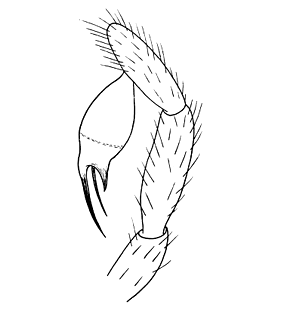Folkia pauciaculeata (Fage, 1943)
Beschreibung
Männchen
Sehr ähnlich wie F. inermis. Augen extrem reduziert. Beinbestachelung: Bein I und II stachellos, ausser Femur mit 5 Stacheln, Patella III und IV mit einem Stachel, Femur III mit 4 Stacheln, Femur IV mit 5 Stacheln, hintere Tibia und Metatarsus mit zahlreichen Stacheln.
Körperlänge Männchen: 4.5 mmWeibchen
Unbekannt.
Zusätzliche Informationen
Nur ein männliches Individuum bekannt. In Höhle.
Troglobionte Art (Mammola et al., 2022)
Verbreitung
Verbreitungsnachweise
"No reference" bedeutet nicht, dass die Art in diesem Land nicht vorkommt, sondern dass wir die Referenz hierfür noch nicht eingefügt haben. Wir arbeiten daran.
Literatur
Deeleman-Reinhold C L (1993) The genus Rhode and the harpacteine genera Stalagtia, Folkia, Minotauria, and Kaemis (Araneae, Dysderidae) of Yugoslavia and Crete, with remarks on the genus Harpactea. Revue Arachnologique 10: 105-135 ![]()
Deltshev C D (2008b) Faunistic diversity and zoogeography of cave-dwelling spiders on the Balkan Peninsula. p. 327-348. In: Makarov S E & Dimitrijevic R N (Eds): Advances in arachnology and developmental biology. Papers dedicated to Prof. Dr. Božidar Curcic. Monographs 12. 517 pp. ![]()
Katušić L (unpubl.) .
Kratochvíl J (1970) Cavernicole Dysderae. Přírodovědné práce ústavů Československé Akademie Věd v Brně (N.S.) 4: 1-62 ![]()
Le Peru B (2011) The spiders of Europe, a synthesis of data: Volume 1 Atypidae to Theridiidae. Mémoires de la Société Linnéenne de Lyon 2: 1-522 ![]()
Mammola S, Pavlek M, Huber B A, Ballarin F, Tolve M, Čupić I, Hesselberg T, Lunghi E, Mouron S, Graco-Roza C, Cardoso P (2022) A trait database and updated checklist for European subterranean spiders. Scientific Data 9(236): 1-13 ![]()
WSC (2025) World Spider Catalog. Version 26. Natural History Museum Bern, online at http://wsc.nmbe.ch (28.2.2025) doi: 10.24436/2 ![]()

